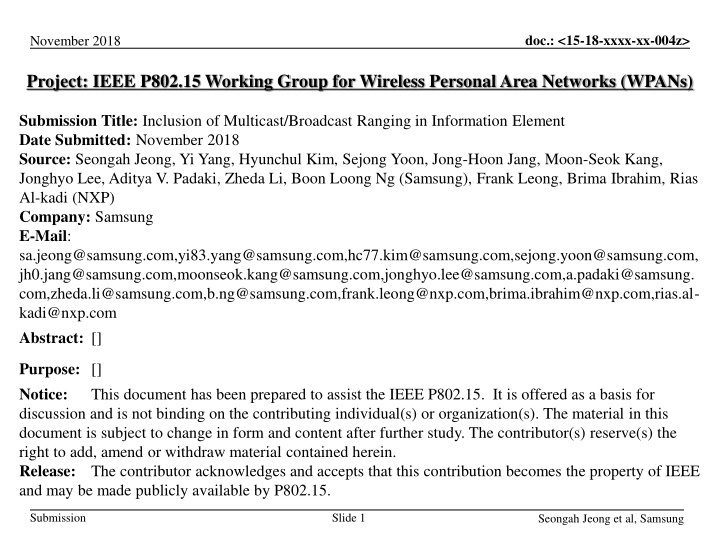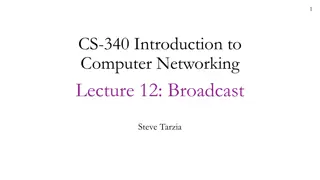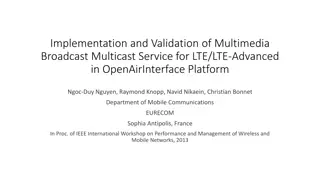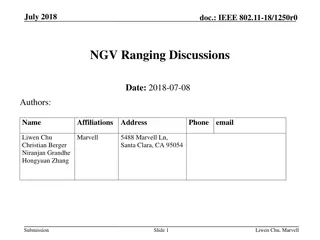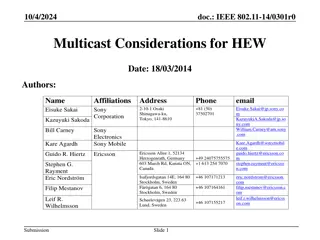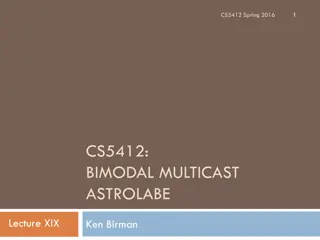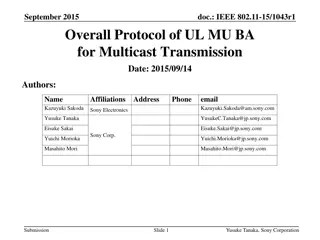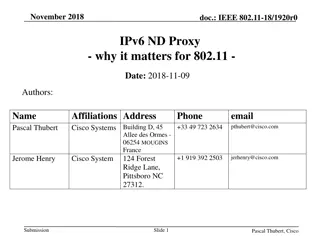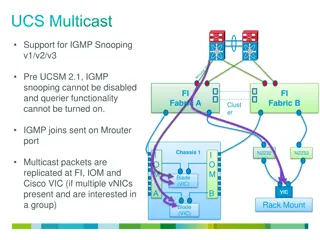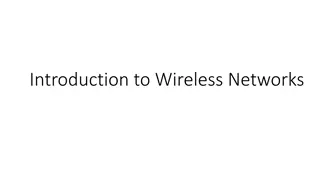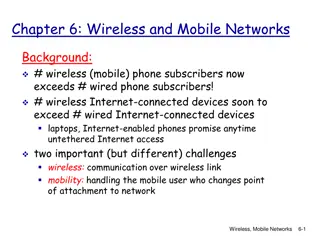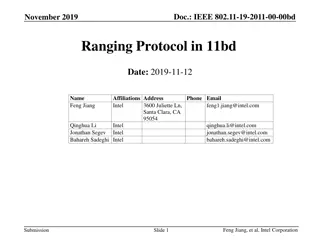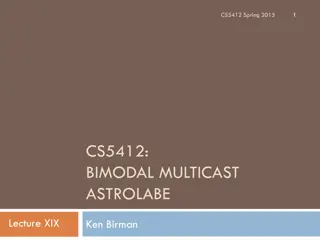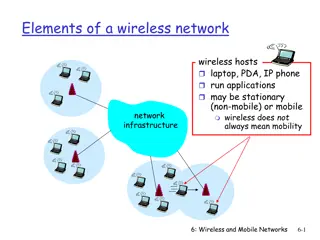Inclusion of Multicast/Broadcast Ranging in Wireless Personal Area Networks
This document discusses the proposal for incorporating multicast/broadcast ranging methods in IEEE P802.15 Working Group for Wireless Personal Area Networks (WPANs). It introduces the concept of double-sided two-way ranging (DS-TWR) for multicast/broadcast ranging and suggests improvements to the existing information elements to support this method. The presentation aims to enhance ranging capabilities in TG4Z and outlines the need for, proposed method, and conclusions of multicast/broadcast ranging.
Download Presentation

Please find below an Image/Link to download the presentation.
The content on the website is provided AS IS for your information and personal use only. It may not be sold, licensed, or shared on other websites without obtaining consent from the author.If you encounter any issues during the download, it is possible that the publisher has removed the file from their server.
You are allowed to download the files provided on this website for personal or commercial use, subject to the condition that they are used lawfully. All files are the property of their respective owners.
The content on the website is provided AS IS for your information and personal use only. It may not be sold, licensed, or shared on other websites without obtaining consent from the author.
E N D
Presentation Transcript
doc.: <15-18-xxxx-xx-004z> November 2018 Project: IEEE P802.15 Working Group for Wireless Personal Area Networks (WPANs) Submission Title: Inclusion of Multicast/Broadcast Ranging in Information Element Date Submitted: November 2018 Source: Seongah Jeong, Yi Yang, Hyunchul Kim, Sejong Yoon, Jong-Hoon Jang, Moon-Seok Kang, Jonghyo Lee, Aditya V. Padaki, Zheda Li, Boon Loong Ng (Samsung), Frank Leong, Brima Ibrahim, Rias Al-kadi (NXP) Company: Samsung E-Mail: sa.jeong@samsung.com,yi83.yang@samsung.com,hc77.kim@samsung.com,sejong.yoon@samsung.com, jh0.jang@samsung.com,moonseok.kang@samsung.com,jonghyo.lee@samsung.com,a.padaki@samsung. com,zheda.li@samsung.com,b.ng@samsung.com,frank.leong@nxp.com,brima.ibrahim@nxp.com,rias.al- kadi@nxp.com Abstract: [] Purpose: [] Notice: discussion and is not binding on the contributing individual(s) or organization(s). The material in this document is subject to change in form and content after further study. The contributor(s) reserve(s) the right to add, amend or withdraw material contained herein. Release: The contributor acknowledges and accepts that this contribution becomes the property of IEEE and may be made publicly available by P802.15. This document has been prepared to assist the IEEE P802.15. It is offered as a basis for Submission Slide 1 Seongah Jeong et al, Samsung
doc.: <15-18-xxxx-xx-004z> November 2018 The aim of this presentation: We support on-going discussion for ranging method in TG4Z Using ranging methods and information element (IE) from 802.15.8 in <15-18-0108-03-004z-hrp-uwb-phy- enhancements.pptx> Revising text 15-15-0429-01-0008 for TG4z in <15-18-0503- 00-004z-status-of-draft-editing-wk4218.pptx> Note: Notation/nomenclature based on 15-15-0429-01-0008 and 802.15.8 Submission Slide 2 Seongah Jeong et al, Samsung
doc.: <15-18-xxxx-xx-004z> November 2018 The aim of this presentation: We suggest multicast/broadcast ranging method based on double-sided two-way ranging (DS-TWR) Multicast/broadcast ranging method is conceptually introduced in <15-18-0286-01-004z-hrp-uwb-srdev-ppdu-text-contribution> We suggest improvements on the existing IE in 802.15.8 for supporting multicast/broadcast ranging method Note: Notation/nomenclature based on 15-15-0429-01-0008 and 802.15.8 Submission Slide 3 Seongah Jeong et al, Samsung
doc.: <15-18-xxxx-xx-004z> November 2018 Overview Need for Multicast/Broadcast Ranging Proposed Multicast/Broadcast DS-TWR Proposed Improvements on IE Conclusions Submission Slide 4 Seongah Jeong et al, Samsung
doc.: <15-18-xxxx-xx-004z> November 2018 Need for Multicast/Broadcast Ranging The symmetric DS-TWR in Annex D1.3.2 of 802.15.4a-2007 is discussed in 802.15.8 as DS-TWR with payload IEs for each transmission The DS-TWR is defined for one-to-one case in 802.15.8 For use cases where one device needs to simultaneously range with N multiple nodes, N number of sequential one-to- one DS-TWR procedures need to be considered with the existing payload IEs This will increase traffic considerably and will lead to increased power/energy consumption and increased latency Submission Slide 5 Seongah Jeong et al, Samsung
doc.: <15-18-xxxx-xx-004z> November 2018 Reference (802.15.8) Figure 116 Double-sided two-way ranging with three messages For DS-TWR between two devices, A and B, we need three messages Transmitted message from A initiating ranging procedure ( ranging poll ) Response message from B initiating 2ndround trip measurement ( ranging response ) Retransmitted message from A completing DS-TWR exchange ( ranging final ) For Device B to calculate the estimated time of flight (ToF) Tprop, Device A needs to communicate its round-trip time Tround1 & reply time Treply2 to Device B 802.15.8 employs payload IEs to control DS-TWR and transfer ranging data in a ranging exchange Submission Slide 6 Seongah Jeong et al, Samsung
doc.: <15-18-xxxx-xx-004z> November 2018 Reference (802.15.8) 1. DS-TWR is initiated by a ranging data frame carrying a Ranging Control Double-sided TWR IE (RCDT IE) with control field set to 0 or 1 according to Table 147 The responding side initiates the second with ranging data frame carrying a Ranging Control Double-sided TWR IE (RCDT IE) with control field set to 2 according to Table 147 and also carrying a Ranging Request Reply Time IE (RRRT IE) The original initiator completes the exchange by sending a final ranging data frame carrying the first round trip time measurement (Tround1) in an Ranging Round Trip Measurement IE (RRTM IE) and the reply time (Treply2) of this second first round trip measurement in an Ranging Reply Time Instantaneous IE (RRTI IE) next higher layer next higher layer MLME UWB PHY UWB PHY MLME MCPS-DATA.request MAC Data Data {Ranging & RCDT(0) IE} MAC Data MCPS-DATA.indication {Ranging, RCDT IE} R FRAME 2. {Ranging, RCDT IE} MCPS-DATA.confirm {with the local value of TxRangingCounter} {carries the local value of the RxRangingCounter and the RCDT IE} MCPS-DATA.request MAC Data {Ranging, RCDT IE & RRRT IE} {Ranging & RCDT(2) IE and RRRT IE} Data MAC Data {Ranging, RCDT IE & RRRT IE} MCPS-DATA.indication R FRAME MCPS-DATA.confirm 3. {with the local value of the RxRangingCounter and RCDT IE & RRRT IE values} {carries the local value of the TxRangingCounter} MCPS-DATA.request MAC Data {with RequestRrtiTx set to insert an RRTI IE at the preferred reply time and the RRTM IE} Data MAC Data MCPS-DATA.indication {with the RRTI IE value, RRTM IE, (and Ranging)} R FRAME (R) {with the RRTI IE value, RRTM IE, (and Ranging)} {carries the local value of RxRangingCounter and the RRTI and RRTM IEs} MCPS-DATA.confirm Figure 121 Message sequence chart for DS-TWR with three messages Octets: 1 Control Info Figure 111 Ranging Control Double-sided TWR (RCDT) IE Content field format Control Info value 0 1 2 Meaning This frame is initiating DS-TWR and indicates that the initiating end does not require the ranging result. This frame is initiating DS-TWR and requesting that the ranging result is sent back at end of exchange This frame is continuing the DS-TWR, forming the request for the 2nd TX-to-RX round trip measurement Table 147 Values of the Control Info field in the Ranging Control Double-sided TWR (RCDT) IE Submission Slide 7 Seongah Jeong et al, Samsung
doc.: <15-18-xxxx-xx-004z> November 2018 Need for Multicast/Broadcast Ranging For use cases where one device needs to simultaneously range with N multiple nodes, N number of sequential one-to- one DS-TWR procedures need to be considered with the existing payload IEs This will increase traffic considerably and will lead to increased power/energy consumption and increased latency Each ranging/secure ranging device (RDEV/SRDEV) calculates ToF from the equation in 802.15.8 Device A Device 1 Device 2 ... Device N (Ranging poll) (Ranging response) (Ranging final) Ranging (Ranging poll) (Ranging response) (Ranging final) Ranging (Ranging poll) (Ranging response) (Ranging final) Ranging Submission Slide 8 Seongah Jeong et al, Samsung
doc.: <15-18-xxxx-xx-004z> November 2018 Proposal We propose to consider Broadcast/Multicast DS-TWR following multicast/broadcast ranging in <15-18-0286-01- 004z-hrp-uwb-srdev-ppdu-text-contribution.docx> Ranging poll and ranging final messages are broadcasted/multi- casted from initiating RDEV/SRDEV which is an efficient way in the aspect of number of transmissions Each RDEV/SRDEV still can calculate ToF from the equation in 802.15.8 The timestamp measurements maybe encrypted for different users with different keys for security (Ranging final/Multicast) Broadcast/multicast (Ranging poll) Device A Device 1 Device 2 ... Device N (Ranging response) (Ranging response) (Ranging response) *Broadcast/multicast single-sided TWR can be considered Broadcast/multicast (Ranging final) Ranging Ranging Ranging Submission Slide 9 Seongah Jeong et al, Samsung
doc.: <15-18-xxxx-xx-004z> November 2018 Proposal For the support of the broadcast/multicast DS-TWR, we propose the additional control info value of RCDT IE The newly defined control info values 3~7 for content field of RCDT IE are proposed as below Octets: 1 Content field of RCDT IE Control Info Control Info Value 0 Meaning Device A Device B This frame is initiating DS-TWR and indicates that the initiating end does not require the ranging result. This frame is initiating DS-TWR and requesting that the ranging result is sent back at end of exchange This frame is continuing the DS-TWR, forming the request for the 2nd TX-to-RX round trip measurement This frame is initiating broadcast/multicast DS-TWR and indicates that the initiating end does not RCDT IE (Ranging poll) 1 RCDT(2) IE, RRRT IE (Ranging response) 2 3 require the ranging result This frame is initiating broadcast/multicast DS-TWR and requesting that the ranging result is sent 4 RCDT IE (Ranging final) back at end of exchange This frame is initiating broadcast/multicast DS-TWR with additional report message for time stam Ranging 5 p measurements and indicates that the initiating end does not require the ranging result This frame is initiating broadcast/multicast DS-TWR with additional report message for time stam 6 p measurements and requesting that the ranging result is sent back at end of exchange This frame indicates Ranging Final message without timestamps in the broadcast/multicast DS-T 7 WR Submission Slide 10 Seongah Jeong et al, Samsung
doc.: <15-18-xxxx-xx-004z> November 2018 Example of RCDT (3) IE Device A Device 1 Device 2 This frame is 1) initiating broadcast/multicast DS-TWR and 2) indicates that the initiating end does not require the ranging result (ToF) ... Device N RCDT(3) IE (Ranging poll) RCDT(2) IE, RRRT IE (Ranging response) RCDT(2) IE, RRRT IE (Ranging response) RCDT(2) IE, RRRT IE (Ranging response) [RRTI IE, RRTM IE] [RRTI IE, RRTM IE] [RRTI IE, RRTM IE] (Ranging final) Ranging Ranging Ranging Submission Slide 11 Seongah Jeong et al, Samsung
doc.: <15-18-xxxx-xx-004z> November 2018 Example of RCDT (4) IE Device A Device 1 Device 2 This frame is 1) initiating broadcast/multicast DS-TWR and 2) requesting that the ranging result (ToF) is sent back at end of exchange ... Device N RCDT(4) IE (Ranging poll) RCDT(2) IE, RRRT IE (Ranging response) RCDT(2) IE, RRRT IE (Ranging response) RCDT(2) IE, RRRT IE (Ranging response) [RRTI IE, RRTM IE] [RRTI IE, RRTM IE] [RRTI IE, RRTM IE] (Ranging final) Ranging Ranging Ranging RTOF IE (Ranging measurement) RTOF IE (Ranging measurement) RTOF IE (Ranging measurement) Submission Slide 12 Seongah Jeong et al, Samsung
doc.: <15-18-xxxx-xx-004z> November 2018 Example of RCDT (5)/RCDT (7) IE Device A Device 1 Device 2 The frame with RCDT (5) IE is 1) initiating broadcast/multicast DS-TWR with additional report message for time stamp measurements (RRTI IE, RRTM IE), not in Ranging final message and 2) indicates that the initiating end does not require the ranging result (ToF) The frame with RCDT (7) IE indicates Ranging Final message without timestamps in the broadcast/multicast DS-TWR ... Device N RCDT(5) IE (Ranging poll) RCDT(2) IE, RRRT IE (Ranging response) RCDT(2) IE, RRRT IE (Ranging response) RCDT(2) IE, RRRT IE (Ranging response) RCDT(7) IE (Ranging final) [RRTI IE, RRTM IE] [RRTI IE, RRTM IE] [RRTI IE, RRTM IE] (Additional report) Ranging Ranging Ranging Submission Slide 13 Seongah Jeong et al, Samsung
doc.: <15-18-xxxx-xx-004z> November 2018 Example of RCDT (6)/RCDT (7) IE Device A Device 1 Device 2 The frame with RCDT (6) IE is 1) initiating broadcast/multicast DS-TWR with additional report message for time stamp measurements (RRTI IE, RRTM IE), not in Ranging final message and 2) requesting that the ranging result (ToF) is sent back at end of exchange The frame with RCDT (7) IE indicates Ranging Final message without timestamps in the broadcast/multicast DS-TWR ... Device N RCDT(6) IE (Ranging poll) RCDT(2) IE, RRRT IE (Ranging response) RCDT(2) IE, RRRT IE (Ranging response) RCDT(2) IE, RRRT IE (Ranging response) RCDT(7) IE (Ranging final) [RRTI IE, RRTM IE] [RRTI IE, RRTM IE] [RRTI IE, RRTM IE] (Additional report) Ranging Ranging Ranging RTOF IE (Ranging measurement) RTOF IE (Ranging measurement) RTOF IE (Ranging measurement) Submission Slide 14 Seongah Jeong et al, Samsung
doc.: <15-18-xxxx-xx-004z> November 2018 Conclusions We support using ranging methods and payload IEs from 802.15.8 For use cases where one device needs to simultaneously range with multiple nodes, efficient support for DS-TWR is required for traffic, power/energy consumption and latency Considering multicast/broadcast DS-TWR with the additional control info value of RCDT IE is proposed Submission Slide 15 Seongah Jeong et al, Samsung
doc.: <15-18-xxxx-xx-004z> November 2018 THE END Submission Slide 16 Seongah Jeong et al, Samsung
